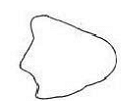As a result of change in the magnetic flux linked to the closed loop shown in the figure, an emf V volt is induced in the loop. The work done (joules) in taking a charge Q coulomb once along the loop is:


QV
zero
2QV
\(\frac{QV}{2}\)
The Correct Option is A
Solution and Explanation
Work required to take a charge equals Q Volt induced in the loop equals V
The amount of work required to move a test charge Q and a loop with an induced emf E is QE.
Due to the non-conservative nature of the generated electric field caused by the change in magnetic field.
Work completed as a result of change will become W=QV.
Consequently, QV is the labour (in joules) involved in taking a charge once along the loop.
Therefore, the correct option is (A): QV
Top Questions on Moving Charges and Magnetism
- A 1 cm straight segment of a conductor carrying 1 A current in \( x \)-direction lies symmetrically at the origin of Cartesian coordinate system. The magnetic field due to this segment at point (1m, 1m, 0) is:
- CBSE CLASS XII - 2025
- Physics
- Moving Charges and Magnetism
- A point charge \( q \) is moving with velocity \( \mathbf{v} \) in a uniform magnetic field \( \mathbf{B} \). Find the work done by the magnetic force on the charge.
- CBSE CLASS XII - 2025
- Physics
- Moving Charges and Magnetism
- What is the source of force acting on a current-carrying conductor placed in a magnetic field? Obtain the expression for the force acting between two long straight parallel conductors carrying steady currents and hence define Ampère’s law.
- CBSE CLASS XII - 2025
- Physics
- Moving Charges and Magnetism
- Write two characteristics of equipotential surfaces. A uniform electric field of 50 NC\(^{-1}\) is set up in a region along the \( x \)-axis. If the potential at the origin \( (0, 0) \) is 220 V, find the potential at a point \( (4m, 3m) \).
- CBSE CLASS XII - 2025
- Physics
- Moving Charges and Magnetism
- Two infinitely long conductors kept along XX' and YY' axes are carrying current \( I_1 \) and \( I_2 \) along -X axis and -Y axis respectively. Find the magnitude and direction of the net magnetic field produced at point P(X, Y).
- CBSE CLASS XII - 2025
- Physics
- Moving Charges and Magnetism
Concepts Used:
Biot Savart Law
Biot-Savart’s law is an equation that gives the magnetic field produced due to a current-carrying segment. This segment is taken as a vector quantity known as the current element. In other words, Biot-Savart Law states that if a current carrying conductor of length dl produces a magnetic field dB, the force on another similar current-carrying conductor depends upon the size, orientation and length of the first current carrying element.
The equation of Biot-Savart law is given by,
\(dB = \frac{\mu_0}{4\pi} \frac{Idl sin \theta}{r^2}\)

Application of Biot Savart law
- Biot Savart law is used to evaluate magnetic response at the molecular or atomic level.
- It is used to assess the velocity in aerodynamic theory induced by the vortex line.
Importance of Biot-Savart Law
- Biot-Savart Law is exactly similar to Coulomb's law in electrostatics.
- Biot-Savart Law is relevant for very small conductors to carry current,
- For symmetrical current distribution, Biot-Savart Law is applicable.
For detailed derivation on Biot Savart Law, read more.